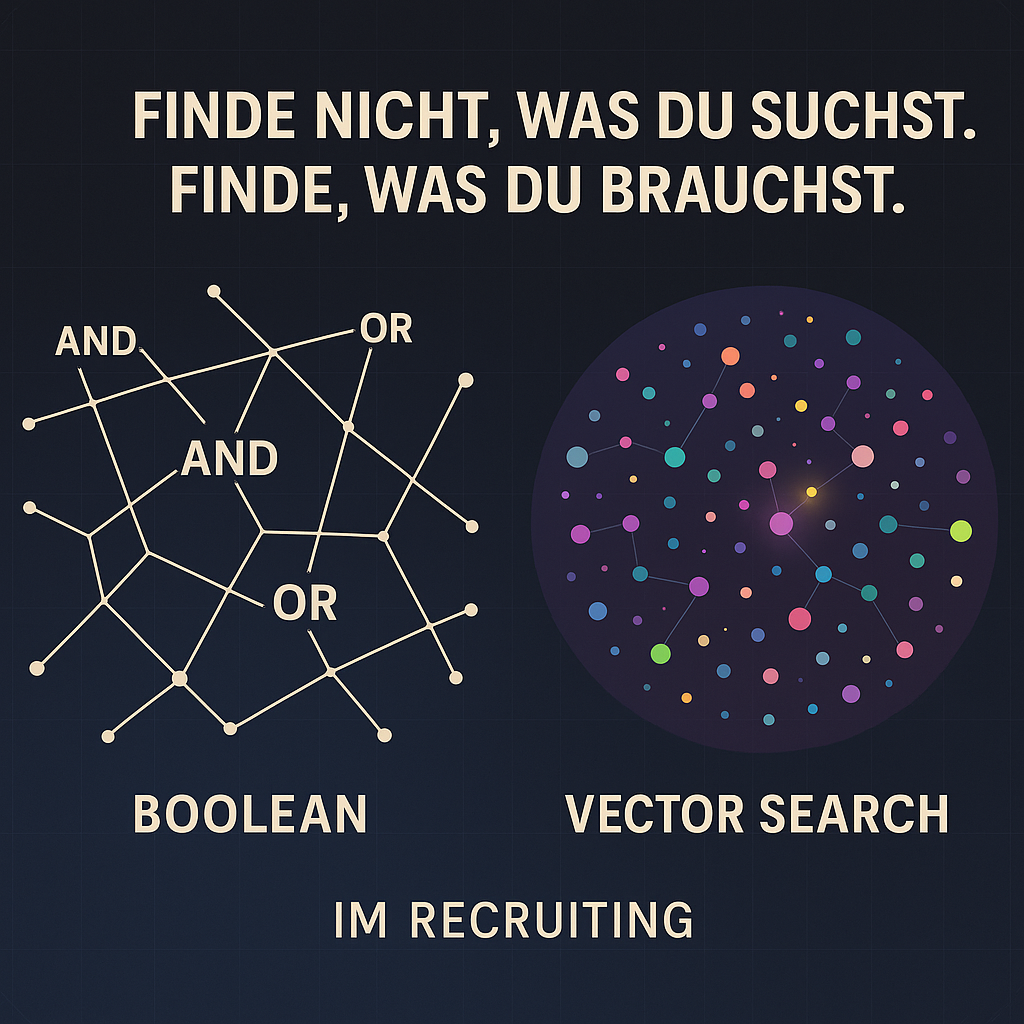Boolean search? Has an expiry date.
Anyone still working with classic AND/OR-If you're tinkering with LinkedIn connections, you're filtering past the best IT candidates every day. Why? This type of search is blind to semantic connections, alternative terms and real skills. Vector Search - semantic vector search based on embeddings - is the most powerful game changer tech recruiting has seen since the introduction of GitHub parsing. While it has long since become standard in the tech world, it is still in its infancy in recruiting - wrongly so.
1. why classic Boolean search reaches its limits in tech recruiting
A typical example:
("DevOps Engineer" OR "SRE") AND (AWS OR Azure) AND (Terraform OR "Infrastructure as Code")
This search looks clever - but it is not. It doesn't understand that an SRE that Pulumi belongs to the target group. Or that someone has actually created CI/CD with "automated YAML pipelines".
Boolean thinks in letters. Vector Search thinks in terms of meaning.
That is the difference between:
✅ "I only look for what I can imagine"
and
✅ "I find what I didn't even know I was looking for."
2 What is Vector Search?
Vector Search is based on so-called text embedding. This involves converting a text - such as a CV, a GitHub profile or a project description - into a mathematical vector. This vector represents the meaning of the text - not the wording.
These vectors can then be compared - according to semantic proximitynot for identical keywords.
Example:
-
"CI/CD with GitHub Actions"
-
"Automated deployments"
-
"Infrastructure Deployment Pipeline via YAML"
Boolean: three completely different terms
Vector Search: almost the same importance
The search is performed using systems that cluster these vectors - intelligently, not stubbornly according to keywords.
3. vector search in practice: what works realistically - without the hype
This article is not a tool review, no advertising, no paid recommendation.
We only share here, what works in real recruiting processes - based on our work with sophisticated tech profiles.
The principle:
Modern semantic search systems allow the input of so-called Prompts - i.e. normal formulations instead of nested Boolean strings. These prompts are converted into embeddings and compared with thousands of profiles.
Our experience:
If a prompt is formulated with technical precision, it delivers Vector Search profiles in seconds that would otherwise fall through the cracks.
If not - the result remains empty. The prompt design is decisive.
4. practical example: DevOps in Munich
❌ Classic Boolean search (e.g. in LinkedIn Recruiter):
("DevOps Engineer" AND "Terraform" AND "AWS") AND location: "Munich"
Result:
-
confusingly many hits
-
Numerous irrelevant results (e.g. job adverts, employer profiles)
-
Many CVs with buzzwords, but without substance
-
Time-consuming post-processing necessary
✅ Semantic search - Prompt 1 (short & clear):
DevOps engineer with IaC experience (Terraform, Pulumi) near Munich
Result:
-
relevant candidates already among the first hits
-
SREs, Cloud Engineers, Platform Engineers
-
GitHub links, real projects, no "buzzword bingo"
✅ Prompt 2 - tool combination:
Cloud infrastructure automation with IaC tools (Terraform, Crossplane, Pulumi). Located in Munich.
Result:
-
Even more accurate profiles
-
GitOps, YAML pipelines, CI/CD projects
-
also freelancers and scale-up profiles
✅ Prompt 3 - Stack-orientated:
Experience with CI/CD, IaC (Pulumi, Terraform), GitHub Actions or ArgoCD in Munich
Result:
-
Developers with a real DevOps stack
-
No title optimisation, but specific project contexts
-
Excellent hit quality for direct approach
Vector Search finds skills - not keywords.
Important for sourcers:
This type of search works not like Google. If a prompt is too long, vague or unspecific (e.g. "Cloud engineer with modern infrastructure"), it often comes: nothing.
Our rule: The more precise the vocabulary, the better the results.
indivHR uses Vector Search - for results that surprise our customers
We at indivHR have been relying on our own semantic sourcing infrastructure since 2023 - based on embedding models, vector space analysis and prompt-optimised search.
This is how we regularly find candidates:
- that do not use classic job titles
- who are not active on any job exchange
- but which a perfect technical and cultural fit
Our clients notice the difference: in the quality of the interviews, the time-to-hire and the cultural fit.
Curious?
If you are wondering why your internal Boolean searches always return the same profiles - and ours do not:





